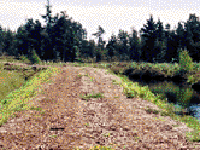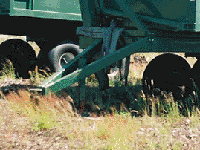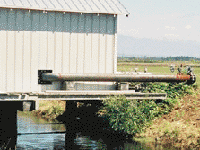|
Farming in Burns Bog is not an easy task. The acidic and waterlogged conditions pose many challenges to the farmers who chose to make a living based on a farm on peatlands, such as Burns Bog. For most crops, Burns Bog is not at all suitable. The high water content of bog soils damage roots of most plants. The acidity problem can be solved by applying lime, but this option requires regular application, the costs of which make farming almost impossible.
However, some crops are adapted to boggy conditions, and can be mass-produced on bog soils. Cranberry and blueberry are the two most common crops in cutaway peatlands.
Cranberry farming often requires installation of ditches. Ditches for agricultural purposes, just like those put in by peat harvesters, disrupt the normal drainage pattern of Burns Bog. Environmentalists are also concerned that cultivated species of cranberries, and blueberries, which are for the most part introduced species, would spread into the Bog and take over the habitat of native species of the same family. It is now possible to find many introduced species, such as the highbush
blueberry, all over Burns Bog. This may threaten Bog
blueberry and Oval-leaved
blueberry, both of which are native species.
There are numerous cranberry farms in boggy areas across the Lower Mainland. The eastern portion of
Richmond, and the fringe of Burns Bog is home to many cranberry productions. In fact, the Lower Mainland Region accounts for some 95% of the entire national production. Despite the small size of the production region, Canada is still the third largest cranberry producer in the world. Because lands suitable for agricultural uses are few in Canada, agricultural land reserves (ALR) were set up to protect the remaining farmlands of Canada. A large portion of Delta is included in the
ALR, including parts of Burns Bog.
The amount of water used in cranberry farming, especially during the harvest stage, is extremely high.
Bogs are ideal places because of the high water demand. The government did not recognize the values of peatlands until very recently, the Canadian
federal government had been encouraging farmers to turn harvested bogs into cranberry farms. As a result, many cutaway bogs are turned into farms instead of being allowed to recover. Today, the threat from urban, industrial, and
waste disposal landuse purposes are a bigger threat to bogs than agriculture.
|

|



|